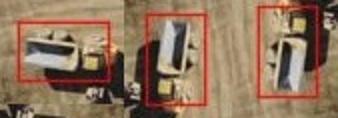As known, modern most popular CNN (convolutional neural network): VGG/ResNet (FasterRCNN), SSD, Yolo, Yolo v2, DenseBox, DetectNet - are not rotate invariant: Are modern CNN (convolutional neural network) as DetectNet rotate invariant?
Also known, that there are several neural networks with rotate-invariance object detection:
Rotation-Invariant Neoperceptron 2006 (PDF): https://www.researchgate.net/publication/224649475_Rotation-Invariant_Neoperceptron
Learning rotation invariant convolutional filters for texture classification 2016 (PDF): https://arxiv.org/abs/1604.06720
RIFD-CNN: Rotation-Invariant and Fisher Discriminative Convolutional Neural Networks for Object Detection 2016 (PDF): http://www.cv-foundation.org/openaccess/content_cvpr_2016/html/Cheng_RIFD-CNN_Rotation-Invariant_and_CVPR_2016_paper.html
Encoded Invariance in Convolutional Neural Networks 2014 (PDF)
Rotation-invariant convolutional neural networks for galaxy morphology prediction (PDF): https://arxiv.org/abs/1503.07077
Learning Rotation-Invariant Convolutional Neural Networks for Object Detection in VHR Optical Remote Sensing Images 2016: http://ieeexplore.ieee.org/document/7560644/
We know, that in such image-detection competitions as: IMAGE-NET, MSCOCO, PASCAL VOC - used networks ensembles (simultaneously some neural networks). Or networks ensembles in single net such as ResNet (Residual Networks Behave Like Ensembles of Relatively Shallow Networks)
But are used rotation invariant network ensembles in winners like as MSRA, and if not, then why? Why in ensemble the additional rotation-invariant network does not add accuracy to detect certain objects such as aircraft objects - which images is done at a different angles of rotation?
It can be:
Why rotation-invariant neural networks are not used in winners of the popular object-detection competitions?



7.9 Implementation ... This allowed the use of GPU acceleration without any additional effort... Networks were trained on NVIDIA GeForce GTX 680 cards.arxiv.org/pdf/1503.07077v1.pdf Also may be rotate-invariantcv::SURF_GPUin some way can be used instead of convolution-kernel (matrix). – Gastrula